#osteichthyes
Text
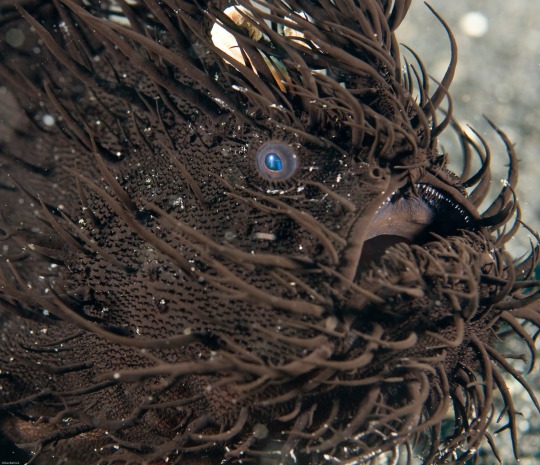
Hairy frogfish (Antennarius striatus)
Photo by Mike Bartick
#hairy frogfish#antennarius striatus#antennarius#antennariinae#antennariidae#antennarioidei#lophiiformes#acanthopterygii#teleostei#actinopterygii#osteichthyes#vertebrata#chordata
2K notes
·
View notes
Photo
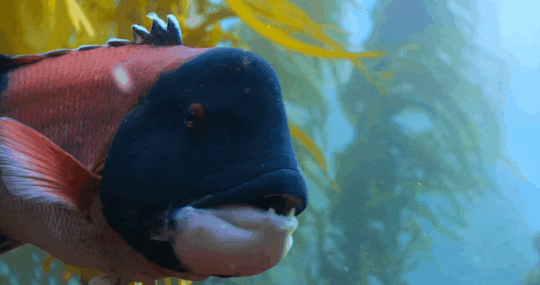
california sheephead (semicossyphus pulcher)
one of the largest members of the wrasse family, the california sheephead is a vital part of kelp forest ecosystems. they prey on shelled creatures, which includes sea urchins, who are kelp grazers. their large teeth allow them to crush through the shells of their prey. they are protogynous fish and often travel in a harem - with one dominant male leading a group of females.
this species is listed as vulnerable on the IUCN red list.
gif creds: our planet (2019)
#zoology#biology#marine biology#ichthyology#osteichthyes#actinopterygii#wrasse#labriformes#labridae#fish#vulnerable species#our planet#california sheephead
197 notes
·
View notes
Text

Sciartober Day 31: And the last one goes to the owlfish for the prompt: dark. There are only video reference for this animal along with a few illustrations, but I wanted to do something from one of MBARI's videos. I corrected the forehead to be less sloped, though the mouth might still be too big for this particular fish. Pentel brushpen, Windsor & Newton fine-line marker, and Prismacolor fine-line marker on Canson mixed media.
#Sciartober#Sciartober 2023#SciartoberDay31#deep sea#MBARI#owlfish#fish#animal#Bathylagidae#Osteichthyes#bony fish#art#my art#sciart#October drawings#October drawings 2023#pen and ink#black and white
28 notes
·
View notes
Text

Rieppelia
Rieppelia — викопний рід лопатеперих риб сучасної родини Латимерієві (Latimeriidae), відомий з середнього тріасу Швейцарії. Типовий і єдиний вид — Rieppelia heinzfurreri.
Повний текст на сайті "Вимерлий світ":
https://extinctworld.in.ua/rieppelia/
#rieppelia#switzerland#triassic#osteichthyes#fish#chordata#ua#paleontology#paleoart#prehistoric#article#palaeoblr#sciart#палеоарт#палеонтологія#ukraine#ukrainian#україна#мова#українська мова#арт#риби#український tumblr#український тамблер#український блог
10 notes
·
View notes
Text

Ever overate at a buffet to get your money's worth? That's the life of a black swallower (Chiasmodon niger).
This species is extremely common in the north atlantic, however it is rarely seen due to its preferred habitat being 700–2,745m (2,297–9,006 ft) below the surface of the ocean.
Unsurprisingly, it is not often that this remarkable fish wanders into a prey species in the vast darkness of the abyss. As such the 15cm to 20cm fish has an unusual strategy to make the most of every encounter.
This fish’s flexible jaw joint allows it to swallow fish much larger than its skull and the distended stomach is an adaptation to hold these huge meals. In fact, the animal has been known to consume prey so large that it begins decomposing before the presses of digestion has fully occurred, in this event the gasses produced by the rotting carcass will cause the fish to become buoyant and float to the surface of the ocean.
#tw animal death#marine life#marine biology#marine animals#marine zoology#marine#deep sea fish#osteichthyes#oceanlife#deep ocean#ocean#ocean life#ocean animals#fish#Ray-Finned Fish
19 notes
·
View notes
Text
Coccodus
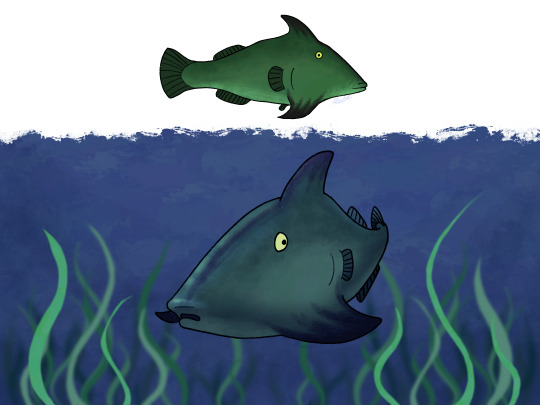
Coccodus was a genus of coccodontid fish from the Late Cretaceous Period. Its type species is C. armatus. Its second known species is C. insignis. C. armatus and C. insignis were found in the Hakel and Hajula Formations in Lebanon, respectively. Unlike most other pycnodontiform fish, which often had a short body, Coccodus has a relatively long body and somewhat resemble the distantly related chimaeras.
C. insignis was differentiated from the type species by its broader lateral spines and relatively short but anteroposteriorly broad occipital spine. A third species, "C." lindstroemi, was named alongside C. insignis, however, the assigned specimens were found to actually belong to the new species of Joinvillichthys lindstroemi, J. kriweti, and Pankowskichthys libanicus.
C. armatus is known from its holotype, which consists of most of the front half of its body. Notably, two large, curved spines are present where pectoral fins would be expected. C. insignis is very similar in shape, but is known from several different skeletons. The greater family Coccodontidae sits within Pycnodontiformes, an extinct order of bony fish. It also has two related families, Gladiopycnodontidae and Gebrayelichthyidae, with which it forms the superfamily Coccodontoidea.
Original papers: C. armatus, C. insignis, C. lindstroemi reassignment
Wikipedia article: Coccodus
#bony fish#ray finned fish#paleoart#paleontology#artwork#original art#human artist#coccodus#coccodontidae#pycnodontiformes#actinopterygii#osteichthyes#obscure fossil animals#obscure fossil fish#obscure fossil tetrapods
2 notes
·
View notes
Text


Further reading and coffee dates
🎧Valentine - Delays
#studyblr#studying#studyspo#study blog#studyspiration#zoology#mine.txt#me#marine biology#fish#osteichthyes#teleosts#biology#zoologist#college#autumn academia#dark academia#study desk#deskspo#mental health#study hard#study#study aesthetic#romantic academia#outfit#student#very tired#science#coffeshop#coffee
15 notes
·
View notes
Text
A tumblr gremlin has reminded me of another fun fact I learned recently:
According to cladistics, we users of tumblr are all fish
Cladistics is a system used to describe relationships between organisms while skirting around the labels of taxonomic classification. Instead of using the group terms of class, order, family, genus, etc., ancestral groups are all clades. Everything within an ancestral group—everything descended from a particular ancestor—is within that ancestral clade. For example, the entire kingdom of plants is a clade, and all the species of prairie grasses are also a clade.
Organisms are divided into clades based on differences in features, paying particular attention to the order in which their features evolved. For instance, skinks that give live birth wouldn’t be in a clade with cats which excludes egg laying vertebrates, because skinks and cats evolved live birth separately. However, mammals that give live birth are in the same clade as platypuses because they share a common ancestor which had three ear bones and produced milk before mammals evolved live birth.
We creatures of the internet are all within the clade Osteichthyes (ahs-tee-IC-thees)—we are descended from bony fish. Therefore, cladistically, we are fish.
You’re welcome
#live your best fish life!#cladistics#fish#taxonomy#fishies#biology#vertebrates#chordata#osteichthyes#evolution#creatures#common descent#common ancestor#goblin things#goblincore#gremlincore#science#fishcore#fish community#phylogeny#phylogenetics#phylogenesis#my posts#paleontology#sea creature#paleocore
0 notes
Note
Birds are class Aves.
Sure, under Linnaean taxonomy. But, well,
A) Linnaeus was a eugenecist so his scientific opinions are suspect and his morality is awful
B) he didn't know about evolution
C) he didn't know about prehistoric life
so his classification system? Sucks ass. It doesn't work anymore. It no longer reflects the diversity of life.
Instead, scientists - almost across the board, now - use Clades, or evolutionary relationships. No rankings, no hierarchies, just clades. It allows us to properly place prehistoric life, it removes our reliance on traits (which are almost always arbitrary) in classifying organisms, and allows us to communicate the history of life just by talking about their relationships.
So, for your own edification, here's the full classification of birds as we currently know it, from biggest to smallest:
Biota/Earth-Based Life
Archaeans
Proteoarchaeota
Asgardians (Eukaryomorphans)
Eukaryota (note: Proteobacteria were added to an asgardian Eukaryote to form mitochondria)
Amorphea
Obazoa
Opisthokonts
Holozoa
Filozoa
Choanozoa
Metazoa (Animals)
ParaHoxozoa (Hox genes show up)
Planulozoa
Bilateria (all bilateran animals)
Nephrozoa
Deuterostomia (Deuterostomes)
Chordata (Chordates)
Olfactores
Vertebrata (Vertebrates)
Gnathostomata (Jawed Vertebrates)
Eugnathostomata
Osteichthyes (Bony Vertebrates)
Sarcopterygii (Lobe-Finned Fish)
Rhipidistia
Tetrapodomorpha
Eotetrapodiformes
Elpistostegalia
Stegocephalia
Tetrapoda (Tetrapods)
Reptiliomorpha
Amniota (animals that lay amniotic eggs, or evolved from ones that did)
Sauropsida/Reptilia (reptiles sensu lato)
Eureptilia
Diapsida
Neodiapsida
Sauria (reptiles sensu stricto)
Archelosauria
Archosauromorpha
Crocopoda
Archosauriformes
Eucrocopoda
Crurotarsi
Archosauria
Avemetatarsalia (Bird-line Archosaurs, birds sensu lato)
Ornithodira (Appearance of feathers, warm bloodedness)
Dinosauromorpha
Dinosauriformes
Dracohors
Dinosauria (fully upright posture; All Dinosaurs)
Saurischia (bird like bones & lungs)
Eusaurischia
Theropoda (permanently bipedal group)
Neotheropoda
Averostra
Tetanurae
Orionides
Avetheropoda
Coelurosauria
Tyrannoraptora
Maniraptoromorpha
Neocoelurosauria
Maniraptoriformes (feathered wings on arms)
Maniraptora
Pennaraptora
Paraves (fully sized winges, probable flighted ancestor)
Avialae
Avebrevicauda
Pygostylia (bird tails)
Ornithothoraces
Euornithes (wing configuration like modern birds)
Ornithuromorpha
Ornithurae
Neornithes (modern birds, with fully modern bird beaks)
idk if this was a gotcha, trying to be helpful, or genuine confusion, but here you go.
all of this, ftr, is on wikipedia, and you could have looked it up yourself.
671 notes
·
View notes
Text
*bony fish. Osteichthyes, after all.
96 notes
·
View notes
Text
Fish Taxonomy
The term fish is commonly used to refer to members of Actinopterygii (ray-finned fish, mostly what people think of when they imagine fish)and Chondrichthyes (cartilaginous fish, the sharks, rays, etc, and chimeras). It is also used for Sarcopterygii (lobe-finned fish, the coelacanths and lungfish) and Agnatha (jawless fish, the hagfish and lampreys), although people don’t talk about lobe-finned and jawless fish as much as they do ray-finned fish and sharks. Tetrapoda (four-limbed vertebrates) is nested within Sarcopterygii, and mostly contains animals which traditionally have not been considered fish (you, me, your cat, the chicken eating your popcorn, the frog hopping away from the chicken). In modern cladistics, this is a little bit of an issue, because the common use of fish as described above is paraphyletic, i.e. it does not include all of the descendants of the group’s last common ancestor. Here are some different ways this issue can be resolved.
Option 1: Fish is not a cladistic term, and therefore we don’t need to worry about whether it’s a good and well formed clade. Reasonable and understandable, we have loads of scientific terms to unambiguously talk about groups of animals, but also boring. Play with me in this space!
Option 2: Fish includes Osteichthyes (Actinopterygii plus Sarcopterygii), Chondrichthyes, and Agnatha, therefore it is essentially synonymous with Vertebrata. You, me, and Moby Dick are all joyfully fish (Melville was right!) (and also a fish). Is this really helpful? Maybe not, but it’s fun.
Option 3: Fish is not a cladistic term, it’s a non-scientific term used to refer to any animal that lives in the water. Jellyfish are fish, starfish are fish, dolphins are fish, humans are not fish, why would you ever suggest such a silly thing?
Option 4: Fish is essentially synonymous with Vertebrata, so why not expand that to all of Chordata? Tunicata and Cephalochordata are welcomed into the Fish Club.
Option 5: Fish is a lifestyle. In the same way that a tree is any plant that gets tall and kinda woody, a fish is an obligate aquatic animal that actively swims. Salmon are fish, tadpoles are fish, frogs are not fish, sea stars are not fish, porpoises are fish, octopuses (-pi, -podes) are fish, most gastropods are not fish, but Phylliroe is absolutely a fish.
Option 6: Fish comes from the Proto-Indo-European root *peysḱ- (“fish”), which is probably derived from *peyt- (“to feed, to guard, to nourish”), and is cognate to lots of words having to do with food (Sanskrit पितु (pitu, “food”), Lithuanian piẽtūs (“lunch”), etc), so if someone asks you “is this a fish?” you must slap it on the grill, maybe squeeze some lemon on it, and find out for yourself.
38 notes
·
View notes
Text
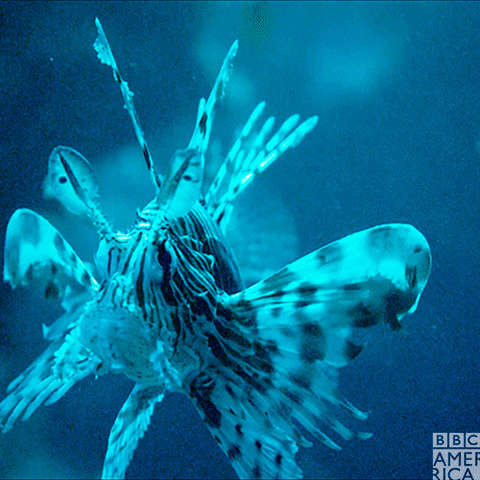
lionfish (genus pterois): a danger to atlantic coral reefs
lionfish are very popular aquarium fish and are easily recognizable by their large, venomous spines, fan-like fins and distinct colouration. they are native to the southern pacific and indian oceans.
lionfish are invasive in southeastern US and caribbean coastal waters. sightings began in southern florida in 1985 and they were documented as established in the early 2000s. their diet consists of many ecologically important species of fish, such as algae-eating parrotfish that prevent seaweed from overtaking coral reefs. the lionfish population in the US continues to increase due to a lack of natural predators and the fact that they reproduce year-round, with females laying around 2 million eggs per year (or about 10,000-30,000 eggs every four days). they also compete for food against snappers and groupers, who are already struggling against overfishing.
one way to help control the invasive lionfish population is to eat them. lionfish are 100% safe for human consumption, as the only venomous part of the fish is the spines themselves. support markets that provide lionfish, or you could even go lionfish hunting yourself! lionfish is one of the best options for food in the US right now, since they're harming the ecosystem and there's an over abundance of them. this is a rare case where we want to overfish this species to extinction (at least in the US).
sources:
X / X
#zoology#actinopterygii#conservation#invasive species#lionfish#marine biology#ichthyology#pterois#fish#biology#osteichthyes
71 notes
·
View notes
Text
Taxonomy uber-hot take: birds are Dinosauria Owen 1842 but not "dinosaurs", much like mammals are Osteichthyes Huxley 1880 but not "fish"
29 notes
·
View notes
Text
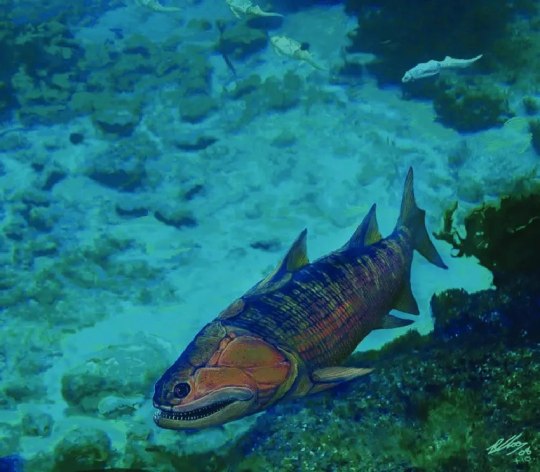
Guiyu
Guiyu — одна з найбільш ранніх відомих кісткових риб. Скам’янілості Guiyu були знайдені на території сучасного міста Цюйцзін, провінція Юньнань, Китай, у морських шарах пізнього силуру, віком близько 425 мільйонів років. Відомий за єдиним описаним видом — Guiyu oneiros.
Повний текст на сайті "Вимерлий світ":
https://extinctworld.in.ua/guiyu/
#guiyu#silurian#fish#china#quijing#ua#osteichthyes#yunnan#paleontology#paleoart#prehistoric#animals#ukraine#ukrainian#illustration#extinct#digital art#fossils#риби#китай#art#палеоарт#палеонтологія#україна#мова#арт#українська мова#український тамблер#science#prehistory
17 notes
·
View notes
Text
Skdjfkejksdjfkejsd. Fuck it. Fine. Fine!!!!!!!!
Here's the lay of the land: there are eleven castes of troll directly correl8ted to 8lood, called the hemospectrum. The higher up on the caste list you are, meaning, the more "royal" your hue, the 8etter you'll 8e treated 8y Alternian society. It's usually divided into three levels of society - low8lood (treated the worst), mid8loods (treated slightly less 8ad) and high8loods (treated gr8). My 8lood is cerulean, so I sit somewhere 8etween mid- and high8lood. Every8ody with me so far? Good. Shut up.
Sometimes there are outliers, affectionately la8eled mutants 8y the Alternian Empire. One of my pals is one such case, and no, he's a pussy, Quinton, he pro8a8ly doesn't want to lie down on the 8rink for you. Anyways, they usually keep their hue hidden 8ecause if the wrong person catches wind of the shit in their veins then they're dead. They'll get killed.
SO ANYWAYS, the two colors at the very top of the hemospectrum differ from the rest of the species 8ecause they're mainly aquatic. They have 8oth a regular respiratory and Osteichthyes respiratory system, meaning they do just as well on land as they do in water. You can't drown them. I've tried. One of these hues shows up all the fucking time, the other does not. That's 8ecause the other one is the line of heirs for the Alternian throne; little Empresses and Emperors in training. When I was alive on Alternia the Condesce would hunt them down and kill the 8astards 8efore they stood a chance to stand up against her, 8ut that's neither here nor there.
Anyways, Cronus is the step just 8elow planet-ruling royalty. That's what Cronus is. That's why he has gills and I don't.
It's 8ecause he's 8orderline fucking royalty and was 8orn with a stick up his ass.
7 notes
·
View notes
Text
loving ned land's reaction to conseil infodumping for two pages about the six orders of the superclass of bony fishes Osteichthyes:
— Avez-vous compris, ami Ned ? demanda le savant Conseil.
— Pas le moins du monde, ami Conseil, répondit le harponneur. Mais allez toujours, car vous êtes très-intéressant. (Vingt mille lieues sous les mers, ch. XIV)
["Did you get all that, friend Ned?" asked the learned Conseil.
"Not even a little, friend Conseil," responded the harpooneer. "But keep going, because you're very interesting."]
#rough translation lol#anyway this is the ideal way u want a friend to react to u going on for 2 pages about the 6 orders of the superclass of bony fishes. imo#right after this conseil goes on to say that there are only three orders of the class of cartilaginous fishes#to which ned's reply is 'even better'#french#literature#my posts#mais allez toujours car vous êtes très-intéressant <-🥺 the dream#actually it just occurred to me that he's probably being sarcastic...eh that's fine i'll take it
2 notes
·
View notes